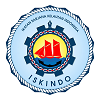Identifikasi Mikroplastik Pada Kerang Simping (Amusium pleuronectes) (Linnaeus, 1758)
Abstract
ABSTRAK
Organisme filter feeder seperti kerang merupakan salah satu organisme yang memiliki resiko cukup besar untuk mengakumulasi mikroplastik, salah satunya yaitu kerang simping (Amusium pleuronectes). Penelitian ini bertujuan untuk mengetahui bentuk mikroplastik, frekuensi kehadiran mikroplastik, konsentrasi mikroplastik dan korelasi antara konsentrasi mikroplastik dengan indeks kondisi kerang yang terdapat pada insang kerang simping (Amusium pleuronectes) di Perairan Selat Makassar, Laut Flores dan Teluk Bone. Penelitian ini dilaksanakan pada bulan Agustus- Oktober 2022. Pengambilan sampel kerang dilakukan dengan metode purposive random sampling dengan 15 sampel untuk setiap perairan yang kemudian dikelompokkan menjadi 3 kelompok ukuran panjang cangkang kerang yaitu 50-70 mm (kelas A), 71-80 mm (kelas B), dan 81-90 mm (kelas C). Pengamatan mikroplastik dilakukan dengan menggunakan mikroskop stereo. Hasil penelitian menunjukkan bahwa mikroplastik yang ditemukan berbentuk serat, pecahan, dan butiran dengan ukuran berkisar 0,2416-2,8153 mm. Total frekuensi kehadiran mikroplastik pada kerang simping pada ketiga lokasi penelitian menunjukkan sebanyak 39 sampel (86,67 %) terpapar mikroplastik.
Kata Kunci: Indeks kondisi; karakteristik dan konsentrasi mikroplastik; kerang simping.
ABSTRACT
Filter feeder organisms such as clams are one of the organisms that have a considerable risk for accumulating microplastics, one of which is the scallop clam (Amusium pleuronectes). This study aims to determine the form of microplastics, the frequency of presence of microplastics, the concentration of microplastics and the correlation between microplastic concentrations and the shell condition index found in the gills of scalloped clams (Amusium pleuronectes) in the waters of the Makassar Strait, Flores Sea and Bone Bay. This research was conducted in August-October 2022. The shell samples were taken using a purposive random sampling method with 15 samples for each waters which were then grouped into 3 groups for the size of the shell length, namely 50-70 mm (class A), 71-80 mm (class B), and 81-90 mm (class C). Microplastic observation was carried out using a stereo microscope. The results showed that the microplastics found were in the form of fibers, fragments and granules with sizes ranging from 0.2416 to 2.8153 mm. The total frequency of the presence of microplastics in scallop shells at the three study locations showed that 39 samples (86.67%) were exposed to microplastics.
Keywords: condition index; characteristics and concentration of microplastics; scallop shells.
Full Text:
PDF (Bahasa Indonesia)References
Afdal, M., Werorilangi, S., Faizal, A., & Tahir, A. (2019). Studies on microplastics morphology characteristics in the coastal water of Makassar City, South Sulawesi, Indonesia. International Journal of Environment, Agriculture and Biotechnology, 4(4), 1028-1033.
Allen, S., Allen, D., Phoenix, V. R., Le Roux, G., Durántez Jiménez, P., Simonneau, A., ... & Galop, D. (2019). Atmospheric transport and deposition of microplastics in a remote mountain catchment. Nature Geoscience, 12(5), 339-344.
Ambarsari, D. A., & Anggiani, M. (2022). Kajian Kelimpahan Mikroplastik Pada Sedimen Di Wilayah Indonesia. Oseana, 47(1), 20-28.
Ayuningtyas, W. C., Defri, Y., Syarifah, H. J., & Feni, I. (2019). Kelimpahan Mikroplastik Pada Perairan Di Banyuurip, Gresik, Jawa Timur. JFMR-Journal of Fisheries and Marine Research, 3(1), 41–45.
Barrett, J., Chase, Z., Zhang, J., Holl, M. M. B., Willis, K., Williams, A., ... & Wilcox, C. (2020). Microplastic pollution in deep-sea sediments from the Great Australian Bight. Frontiers in Marine Science, 7, 576170.
Browne, M. A., Crump, P., Niven, S. J., Teuten, E., Tonkin, A., Galloway, T., & Thompson, R. (2011). Accumulation of microplastic on shorelines woldwide: sources and sinks. Environmental science & technology, 45(21), 9175-9179.
Cole, M., Lindeque, P., Halsband, C., & Galloway, T. S. (2011). Microplastics as contaminants in the marine environment: a review. Marine pollution bulletin, 62(12), 2588-2597.
Cordova, M. R., & Wahyudi, A. A. J. (2016). Microplastic in the deep-sea sediment of Southwestern Sumatran Waters. Marine Research in Indonesia, 41(1), 27-35.
Costa, E., Piazza, V., Lavorano, S., Faimali, M., Garaventa, F., & Gambardella, C. (2020). Trophic transfer of microplastics from copepods to jellyfish in the marine environment. Frontiers in Environmental Science, 8, 571732.
Dahuri, R., Rais, S.P., Ginting., M.J., dan Sitepu. (1996). Pengelolaan Sumberdaya Pesisir dan Lautan Secara Terpadu. Jakarta: PT. Pramadya Paramita
De Witte, B., Devriese, L., Bekaert, K., Hoffman, S., Vandermeersch, G., Cooreman, K., & Robbens, J. (2014). Quality assessment of the blue mussel (Mytilus edulis): Comparison between commercial and wild types. Marine pollution bulletin, 85(1), 146-155.
Departemen Kelautan dan Perikanan, Panduan Penyusunan Rencana Kawasan Perikanan Budidaya. (2010).
Dewi, I. S., Budiarsa, A. A., & Ritonga, I. R. (2015). Distribusi mikroplastik pada sedimen di Muara Badak, Kabupaten Kutai Kartanegara. Depik, 4(3).
EFSA Panel on Contaminants in the Food Chain (CONTAM). (2016). Presence of microplastics and nanoplastics in food, with particular focus on seafood. Efsa Journal, 14(6), e04501.
García, N. L., Ribba, L., Dufresne, A., Aranguren, M., & Goyanes, S. (2011). Effect of glycerol on the morphology of nanocomposites made from thermoplastic starch and starch nanocrystals. Carbohydrate polymers, 84(1), 203-210.
GESAMP Joint Group of Experts on the Scientific Aspects of Marine Environmental Protection. (2015). Sources, fate and effects of microplastics in the marine environment: a global assessment”. Reports and Studies GESAMP, 90, 96.
GESAMP. (2016). Sources, fate and effects of microplastics n the marine environment: part two of a global assessment in IMO/FAO/UNESCOIOC/ UNIDO/WMO/ IAEA/UN/UNEP/UNDP Joint Group of Experts on the Scientific Aspects of Marine Environmental Protection. Report Studies GESAMP No 93. eds P. J. Kershaw and C. M. Rochman, 220.
Gewert, B., Ogonowski, M., Barth, A., & MacLeod, M. (2017). Abundance and composition of near surface microplastics and plastic debris in the Stockholm Archipelago, Baltic Sea. Marine pollution bulletin, 120(1-2), 292-302.
Gewert, B., Plassmann, M. M., & MacLeod, M. (2015). Pathways for degradation of plastic polymers floating in the marine environment. Environmental science: processes & impacts, 17(9), 1513-1521.
Hastuti, L. S. S., Arifin, A., & Subagya, S. (2016). Pengembangan Desain Produk Seni Kerajinan Kerang Simping. Dinamika Kerajinan dan Batik, 28(1), 37-42.
Hoegh Guldberg, O., dan smith (2015). Plastic wate inputs from land into the ocean. Science, (September 2014), hal. 1655–173.
Jambeck, J. R., Geyer, R., Wileox, C., Siegler, T. R., Perryman, M., Andrady, A., dan Lavender Law, K. (2015). Plastic Waste Inputs from Land Into The Ocean. Plastic Waste Inputs from Land Into The Ocean, (January), 1655–1734.
Jaya, A. A., Ratnasari, R., Hamal, R., & Nurdin, F. (2022, December). Identifikasi mikro plastik pada kolom air perairan dan ikan budidaya di Kec. Mandalle, Kab. Pangkep. In Prosiding Seminar Nasional Politeknik Pertanian Negeri Pangkajene Kepulauan (Vol. 3, pp. 1-11).
Khoironi, A., Anggoro, S., & Sudarno. (2018, March). The existence of microplastic in Asian green mussels. In IOP Conference Series: Earth and Environmental Science (Vol. 131, p. 012050). IOP Publishing.
KKP (Kementerian Kelautan dan Perikanan). (2014). Peraturan Menteri Kelautan dan Perikanan Republik Indonesia Nomor 18/PERMEN-KP/2014 Tentang Wilayah Pengelolaan Perikanan Republik Indonesia.
Law, K. L., & Thompson, R. C. (2014). Microplastics in the seas. Science, 345(6193), 144-145.
Li, J., Green, C., Reynolds, A., Shi, H., & Rotchell, J. M. (2018). Microplastics in mussels sampled from coastal waters and supermarkets in the United Kingdom. Environmental pollution, 241, 35-44.
Li, J., Yang, D., Li, L., Jabeen, K., & Shi, H. (2015). Microplastics in commercial bivalves from China. Environmental pollution, 207, 190-195.
Linggi, G. N. T., Yaqin, K., Parawansa, B. S., Fachruddin, L., Yunus, B., & Rahim, S. W. (2021, October). The concentration of microplastics in epibiont of green mussel (Perna viridis) from Maccini Baji waters, Pangkajene Kepulauan. In IOP Conference Series: Earth and Environmental Science (Vol. 860, No. 1, p. 012099). IOP Publishing.
Ng, K. L., dan Obbard, J. P. (2006). Prevalence of microplastics in Singapore’s coastal marine environment. Marine Pollution Bulletin, 52(7), 761–767.
Ningrum, E.W. (2016). Efektivitas Depurasi Merkuri Pada Kerang Hijau (Perna viridis L.) Dan Kerang Darah (Anadara granosa L.) Dari Teluk Jakarta Dengan Penggunaan Ozon, Kitosan Dan Teknik Hidrodinamik. Bogor: Departemen Biologi Fakultas Matematika Dan Ilmu Pengetahuan Alam Institut Pertanian Bogor.
Ningsih, W. (2020). Konsentrasi Mikroplastik di Perairan Pantai Kecamatan Larompong Selatan, Kabupaten Luwu, Sulawesi Selatan. Skripsi, Program Sarjana. Program Studi Manajemen Sumber Daya Perairan, Fakultas Ilmu Kelautan dan Perikanan.
Pipih, S., Yanuarizki O., dan Nurjanah. (2013). Aktivitas Antioksidan dan Komponen Bioaktif Kerang Simping (Amusium pleuronectes). Jurnal Pengolahan Hasil Perikanan Indonesia, 16(3), 242-248.
Purwaningsih, D. (2009). Adsorpsi multi logam Ag (I), Pb (II), Cr (III), Cu (II) dan Ni (II) pada hibrida etilendiamino-silika dari abu sekam padi. Jurnal Penelitian Saintek, 14(1), 59-76.
Qiu, Q., Peng, J., Yu, X., Chen, F., Wang, J., & Dong, F. (2015). Occurrence of microplastics in the coastal marine environment: first observation on sediment of China. Marine Pollution Bulletin, 98(1-2), 274-280.
Rahim, Z., Zamani, N. P., & Ismet, M. S. (2022). Kontaminasi Mikroplastik pada Perna viridis di Teluk Lampung. Jurnal Kelautan Tropis, 25(1), 48-56.
Ramli, K. Y., & Rukminasari, N. (2021). Kontaminasi mikroplastik pada kerang hijau Perna viridis di Perairan Pangkajene Kepulauan, Sulawesi Selatan, Indonesia. Jurnal Akuakultur, Pesisir Dan Pulau-Pulau Kecil, 5(1), 1-5.
Reni, N.S. (2015). Berbagai Cara Penanggulangan Limbah Plastik. Jurnal Prodi Kimia, 98-100.
Sianturi, K. P. T., Amin, B., & Galib, M. (2021). Microplastic distribution in sediments in coastal of Pariaman City, West Sumatera Province. Asian Journal of Aquatic Sciences, 4(1), 73-79.
Tamrin, W. (2020). Konsentrasi Mikroplastik pada kerang tahu di pantai lemo, Kecamatan Burau, Kabupaten Luwu Timur, Sulawesi Selatan. Skripsi. Fakultas Ilmu Kelautandan Perikanan, Universitas Hasanuddin Makassar.
Tongchan, P., Prutipanlai, S., Niyomwas, S., and Thongraung, C. (2009). Effect of Calcium Compound Obtained from fish by-product on Calcium Metabolism in Rats. Journal Food Agriculture-Industry, 2(4), 669-676.
Tuhumury, N. C., & Kaliky, I. (2019). Identifikasi Sampah Pesisir di desa rumah tiga kota Ambon. TRITON: Jurnal Manajemen Sumberdaya Perairan, 15(1), 30-39.
Van Cauwenberghe, L., & Janssen, C. R. (2014). Microplastics in bivalves cultured for human consumption. Environmental pollution, 193, 65-70.
Vandermeersch, G., Van Cauwenberghe, L., Janssen, C. R., Marques, A., Granby, K., Fait, G., ... & Devriese, L. (2015). A critical view on microplastic quantification in aquatic organisms. Environmental Research, 143, 46-55.
Wahdani, A., Yaqin, K., Rukminasari, N., Inaku, D. F., & Fachruddin, L. (2020). Konsentrasi Mikroplastik Pada Kerang Manila venerupis philippinarum di Perairan Maccini Baji, Kecamatan Labakkang, Kabupaten Pangkajen Kepulauan, Sulawesi Selatan. Maspari Journal: Marine Science Research, 12(2), 1-14.
Widinarko dan Inneke. (2018). Mikroplastik dalam seafood dari pantai Utara
Jawa Unika. Semarang: Soegijapranata. ISBN 978-602-6865-74-8.
Yaqin, K. (2018). Efek ukuran panjang cangkang terhadap Indeks Kondisi, dan Kandungan Logam Timbel Kerang Hijau (Perna viridis)(Effects of Shell Length on the Condition Index, and Lead Content of Green Mussel (Perna viridis)). Jurnal Pengelolaan Perairan, 1(2), 27-40.
Yaqin, K., Nirwana, N., & Rahim, S. W. (2022). Konsentrasi Mikroplastik pada Kerang Hijau (Perna viridis) di Perairan Mandalle Pangkajene Kepulauan, Sulawesi Selatan. Jurnal Akuatiklestari, 5(2), 52-57.
Yaqin, K., Nursyamsiah, U., MT, F. L., & Bachtiar, B. (2014). Apakah variasi ukuran panjang cangkang memengaruhi konsentrasi logam timbal di dalam daging kerang hijau Perna viridis. Prosiding Simposium Nasional I Kelautan dan Perikanan. Fakultas Ilmu Kelautan dan Perikanan. Universitas Hasanuddin. Makassar.
Yusuf, M. A., & Tahir, A. (2021). Study of The Abundance and Characteristics of Microplastic Contamination in The Fish of Capture Results of Fishermen in The Lake Towuti Waters, East Luwu, South Sulawesi. Int. J. Sci. Res. Publ, 11, 699-704.
DOI: https://doi.org/10.21107/jk.v17i1.21666
Refbacks
- There are currently no refbacks.

This work is licensed under a Creative Commons Attribution 4.0 International License.

Jurnal Kelautan by Program Studi Ilmu Kelautan is licensed under a Creative Commons Attribution 4.0 International License.
Published by: Department of Marine Sciences, Trunojoyo University of Madura













